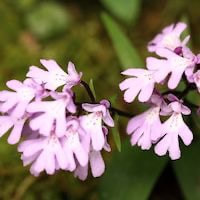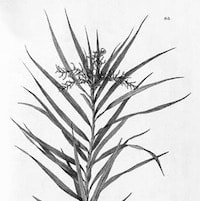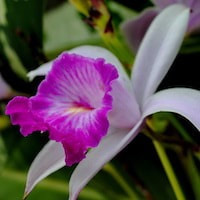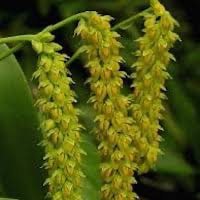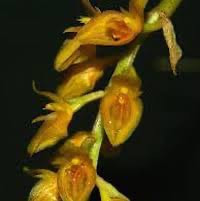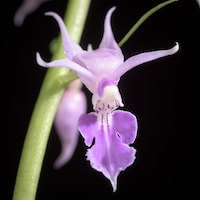MOR4- Men's Oriental 4 - Dark Musk
|
Native Singaporean Orchid notes: Zygopetalum Crinitum
Zygopetalum Crinitum
Zygopetalum crinitum is a medium-sized orchid native to Brazil, characterized by pseudobulbs and found in dense undergrowth of exposed mountains and regenerating forests. It thrives in moderate shade with gentle air movements. Included in Oriental 4 (Men) for Team building Perfume workshop due to its spicy-floral fragrance akin to narcissus, it adds an exotic note to perfumes. Responsible sourcing of natural ingredients is crucial to preserve orchid habitats, suggesting synthetic alternatives for sustainable perfumery practices. |
Therapeutic Orchid notes:
|
Amitostigma gracile (Blume) Schltr
Amitostigma gracile, also known as Xitingwuzhu Lan, Xiewuzhu Lan, and Huawuzhu Lan in Chinese, is a small terrestrial orchid found in the Himalayas, China, and Japan. It features spheroid, subterranean tubers and lacks a visible stigma in its flowers, explaining its name derived from Greek. In traditional Chinese medicine, known as Duyeyizhiqiang, the whole plant is used for detoxification, swelling relief, and to stop bleeding. It's applied externally for venomous snake bites and prepared as a decoction for treating external injuries, vomiting blood, painful menstruation, and irregular uterine bleeding. Caution is advised in using these remedies, respecting their conservation and consulting with qualified practitioners due to potential interactions and side effects. |
|
Apostasia nuda R. Br.
Apostasia nuda, also known as Si sarsar bulang, Si marsari sari, Duhut bane-bane, Poko pulumpus bedak, Dudulu ingap, and Kniching pelandok in Malay, is a primitive terrestrial orchid belonging to the genus Apostasia. It thrives in lowland dipterocarp forests across Malaysia and can also be found in Myanmar, southern Thailand, and parts of Indonesia. Unlike typical orchids, Apostasia nuda has inconspicuous flowers and a grass-like appearance, making it less recognizable as an orchid to the casual observer. In Malaysian traditional medicine, its roots are boiled to create poultices used externally to treat diarrhea, highlighting its cultural and medicinal importance. Research into Apostasia nuda's ecological role and potential medicinal properties continues to unfold, driven by its unique characteristics and local significance. |
|
Arundina graminifolia - It was one of 3 orchid that reappear in Krakatoa after the massive volcanic eruption in 1883 .
Apostasia nuda R. Br., commonly known as the Bamboo Orchid, is a primitive terrestrial orchid found across Asia, including China, Taiwan, Indonesia, Malaysia, Thailand, Vietnam, and Myanmar. Despite its unassuming appearance, this orchid holds cultural and medicinal significance. In traditional medicine, it is used for treating conditions such as diarrhea, sore eyes, rheumatic pain, and urinary tract infections. It contains unique stilbenoids like arundin, known for their anti-tumor and anti-viral properties. The orchid's resilience, demonstrated by its survival on Krakatoa post-eruption, underscores its cultural symbolism of strength and regeneration. Further scientific research is needed to explore its medicinal potential fully and validate its traditional uses, offering potential insights for modern medicine. |
|
Bulbophyllum cariniflorum and Bulbophyllum densiflorum
Bulbophyllum cariniflorum and Bulbophyllum densiflorum, known as "Jianyeshiduo Lan" in China and "Sumura" in India, are orchid species found across Asia, thriving in moist habitats and blooming during the monsoon season. In India, these orchids are traditionally used to induce abortion during early pregnancy in certain regions like Orissa, where dried root paste with black pepper and cow's milk is consumed. This practice is controversial and potentially unsafe, underscoring the need for cautious evaluation of traditional medicinal uses. Scientific exploration into their chemical composition and medicinal properties is limited, requiring further research to understand their potential benefits and ensure safe practices in healthcare. |
|
Bulbophyllum sterile
Bulbophyllum sterile, also known as Bulbophyllum nilgherrense or Cirrhopetalum neilgherrense, is an orchid species found in India, known for its potential medicinal properties. Extracts from its leaves and pseudobulbs have shown antibacterial activity against bacteria like Escherichia coli and Staphylococcus aureus, making it a promising candidate for natural antimicrobial research. The Valmikis tribe in India traditionally consumes the orchid's tubers for health benefits, reflecting local knowledge on plant use. However, sustainable harvesting and conservation efforts are crucial to preserve orchids and their habitats. Further scientific studies are needed to explore Bulbophyllum sterile's chemical composition and potential applications in medicine, respecting both scientific inquiry and traditional wisdom. |
|
Calanthe puberula Lindl. Syn. Calanthe similis Schltr.
Calanthe puberula, also known as Calanthe similis, is an orchid species found in regions like Yunnan, Guangxi, and Guandong in China. It holds multiple Chinese names reflecting its distinct features. In traditional Chinese medicine, the whole plant of Calanthe puberula is utilized to treat ailments such as scrofula and skin sores, offering antipyretic and detoxifying benefits. In Taiwan, it is used for conditions like ulcers, scarlet fever, and dysentery, known for improving blood flow and relieving pain. While traditional uses highlight its potential, scientific research is essential to validate its medicinal properties and ensure safe application in healthcare practices. Understanding its chemical composition could unveil new therapeutic potentials and support conservation efforts for this valuable orchid species. |
Other scent note
Scentopia Library Reference ingredient
Nutmeg - Sir Raffles Collection - Check details at Scentopia's scent library
Download the guided mediation that works best with this Orchid fragrance oil
| men_oriental_essential_oil_orchi_00004.mp3 | |
| File Size: | 85609 kb |
| File Type: | mp3 |

